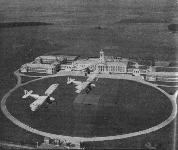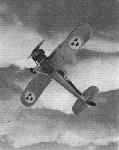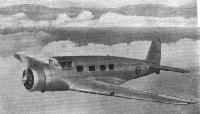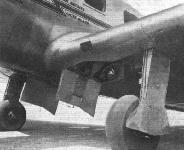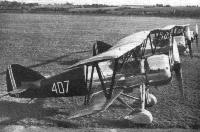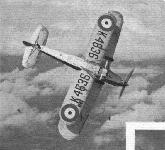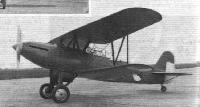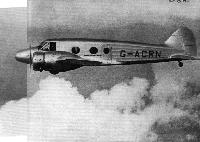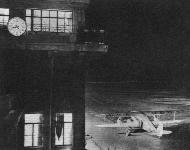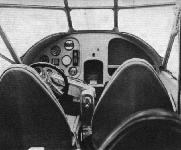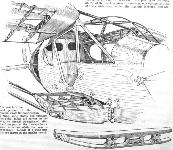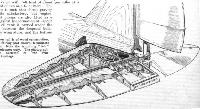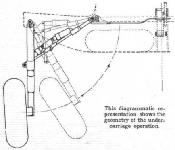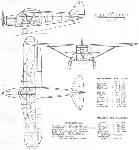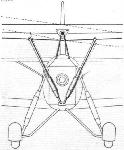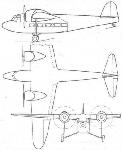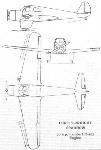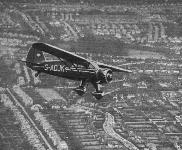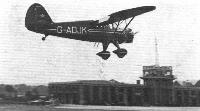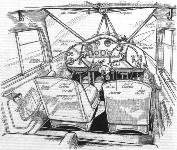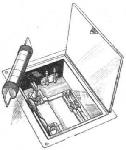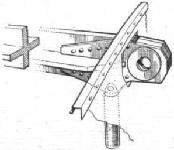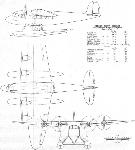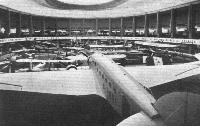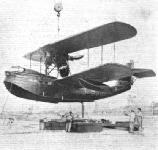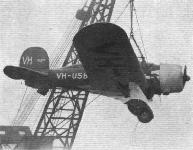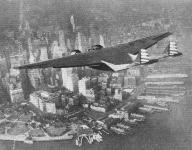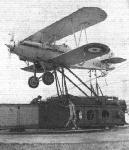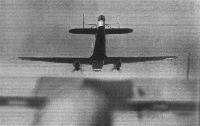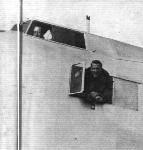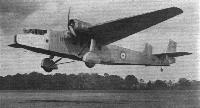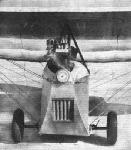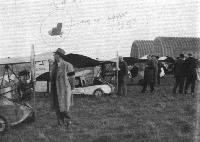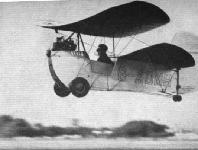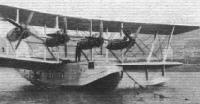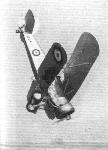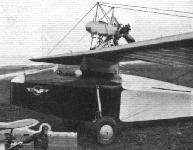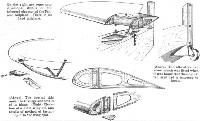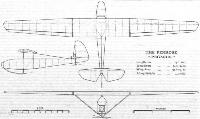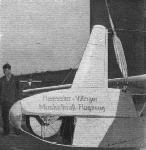Фотографии
-
READY FOR REHEARSAL. Some - if not all - of Germany's Heinkel single-seater fighters (B.M.W. engines) waiting to play their part in manoeuvres near Warnemund recently. The tail in the foreground is that of Udet's acrobatic Curtiss Hawk.
Самолёты на фотографии: Curtiss F11C / Hawk II / BFC-2 / Model 35 - США - 1932Heinkel He-51 - Германия - 1933
-
Like its civil predecessor, the new Vultee has an inwardly retracting undercarriage. This view shows the "German" tail unit to advantage.
Самолёты на фотографии: Vultee V-11 - США - 1935
-
This sketch of the roomy pilot's cockpit of the Vultee attack-bomber shows that, despite the profusion of "gadgets," an orderly layout has been attained.
Самолёты на фотографии: Vultee V-11 - США - 1935
-
CRANWELL: A fine aerial impression of Hawker Harts flying over the R.A.F. Cadet College at Cranwell. In common with that of other R.A.F. centres, the work of the College has been considerably increased by the expansion. Not only are flight cadets turned out as permanent officers, but university candidates for commissions go through a course there.
Самолёты на фотографии: Hawker Hart - Великобритания - 1928
-
Going Down: A Pegasus-Hart for Sweden demonstrate how dive bombers enter their dives. Sweden, incidentally is employing her Harts very extensively for dive bombing.
Самолёты на фотографии: Hawker Hart - Великобритания - 1928
-
CRUISING AT 215 M.P.H.: The latest V1-A Vultee commercial machine flying above the clouds of Southern California.
Самолёты на фотографии: Vultee V-1A - США - 1933
-
This view shows the Vultee's retractable undercarriage, with one of the wheel wells and automatically closing cover. Note also the concealed landing light and, on the leading edge, the indirect ventilation intake.
Самолёты на фотографии: Vultee V-1A - США - 1933
-
LESS AND LESS: The Martin and Sikorsky companies have lately produced flying boats of startling aerodynamic efficiency and now the Consolidated company has contributed to the concerted "cleaning up" by making provision in this new P3Y-1 patrol boat for the floats to be hoisted up in flight to form the tips of the wing. Incidentally, this is the boat which made the fine Panama-'Frisco flight recorded on this page last week. Sixty of these machines are being built for the U.S. Navy.
Самолёты на фотографии: Consolidated PBY Catalina - США - 1935
-
MAKING UP HIS MIND: After finding that half the undercarriage of his Boeing had attempted to sever all connections with the machine, this U.S. Army pilot cruised round for 2 1/2 hours trying to decide if he should try to land it or make an exit with his Irvin. He chose the latter course.
Самолёты на фотографии: Boeing F4B / P-12 - США - 1928
-
SHINING BLADES FOR NORWAY: Three of a batch of four Panther-engined A.W. Scimitar fighters which is soon to be delivered to Norway, The Norwegian Government has secured the licence to build further machines of this type.
Самолёты на фотографии: Armstrong Whitworth Scimitar / A.W.16 / A.W.35 - Великобритания - 1931
-
A COMMUTING SHIP - or what we should know as a business man's aeroplane, is the Boeing 247D of the American Phillips Petroleum Company. Here an official of that company is seen using an inter-'phone RT set to talk to ground wireless stations. The equipment can be used, in addition, for communication between the cabin and the pilots' compartment.
Самолёты на фотографии: Boeing Model 247 - США - 1933
-
RECORD BREAKERS ON SHOW: Among the exhibits at the Milan International Aircraft Exhibition, which opened on October 12, are the Macchi-Castoldi which did 440.67 m.p.h., the Cant. 501 seaplane which recently flew 3,104 miles non-stop, and what appears to be a two-seater version of the Caproni biplane which holds the altitude record. The monoplane in the background is the new Potez light transport.
Самолёты на фотографии: CANT Z.501 Gabbiano - Италия - 1934Caproni Ca.161 - Италия - 1936Macchi MC.72 - Италия - 1931Potez Potez 56 - Франция - 1934
-
THE NEWEST JUNKERS: Well-tried Junkers features are retained in the Ju. 86, a ten-passenger twin-engined high-speed machine which will be put into service by D.L.H. next year. The stressed skin is, however, smooth in this machine, which has a maximum speed of 225 m.p.h.
Самолёты на фотографии: Junkers Ju.86 - Германия - 1934
-
Регистрационный номер: K3692 The Attack: Dive bombing has recently been added to the functions of army co-operation squadrons. Here the two leading "Audax" machines are beginning to "cartwheel" in turn into the dive.
Самолёты на фотографии: Hawker Audax - Великобритания - 1931
-
Регистрационный номер: K4636 Going Down: An R.A.F. Hind (Kestrel V) light bomber demonstrate how dive bombers enter their dives.
Самолёты на фотографии: Hawker Hind - Великобритания - 1934
-
Самолёты на фотографии: Hawker Hind - Великобритания - 1934
-
The Fokker C X two-seater fighter, bomber, reconnaissance machine, or what you will, fitted with the 600/640 h.p. Rolls-Royce Kestrel V. Alternative engines are the Hispano Suiza Ydrs, Bristol Pegasus IV and Gnome Rhone 14 Krsf Mistral Major. The performance with the two foreign engines is rather higher, but not sufficiently so, it would seem, to outweigh the very much shorter range. With the Hispano this is 410 miles, compared with 515 from the Kestrel. The more powerful engine gives 214 m.p.h. at 13,000 ft, whereas the Kestrel gives 199 m.p.h. at 14,000 ft.
Самолёты на фотографии: Fokker C.X - Нидерланды - 1934
-
Самолёты на фотографии: Fokker C.X - Нидерланды - 1934
-
The layout of the Loire 21 fleet fighter seaplane is of unusual interest. A 750 h.p. Hispano-Suiza 9 Vbrs. nine-cylinder radial (Wright Cyclone built under licence) is the power plant and drives a controllable-pitch airscrew.
Самолёты на фотографии: Loire Loire 210 - Франция - 1935
-
Самолёты на фотографии: Loire Loire 210 - Франция - 1935
-
Регистрационный номер: G-ACRN Самолёты на фотографии: Avro Anson / Type 652 - Великобритания - 1935
-
Регистрационный номер: G-ADJB, G-ADJH FOR THE RESERVE SCHOOLS: A batch of D.H. Tiger Moths at Hatfield before being delivered.
Самолёты на фотографии: De Havilland Tiger Moth / D.H.82 - Великобритания - 1931
-
Регистрационный номер: G-ACWD TOWARDS HONG KONG: The Imperial Airways D.H.86 Dorado at Penang. On the left can be seen the four members of the crew, including Capt. W. Armstrong. Third from the right is Major R. L. Nunn, the D.C.A. for Malaya.
Самолёты на фотографии: De Havilland Express Air Liner / D.H.86 - Великобритания - 1934
-
Регистрационный номер: G-ADCN Imperial Airways D.H.86 Daedalus on the Croydon tarmac under the new floodlighting. The line in the background is the black and white boundary fence.
Самолёты на фотографии: De Havilland Express Air Liner / D.H.86 - Великобритания - 1934
-
A typical dashboard layout for a commercial machine - in this case a D.H. 86 with Sperry equipment.
Самолёты на фотографии: De Havilland Express Air Liner / D.H.86 - Великобритания - 1934
-
Самолёты на фотографии: Heston Phoenix - Великобритания - 1935
-
Регистрационный номер: G-ADAD [2] A side view of the Phoenix. The Titanine finish is pale green, picked out in darker green, and silver.
Самолёты на фотографии: Heston Phoenix - Великобритания - 1935
-
The photograph shows the skeleton of the rear monocoque fuselage.
Самолёты на фотографии: Heston Phoenix - Великобритания - 1935
-
Регистрационный номер: G-ADAD [2] Самолёты на фотографии: Heston Phoenix - Великобритания - 1935
-
In spite of its wide fuselage, the Phoenix is very "clean." This photograph also gives a good idea of the pilot's view.
Самолёты на фотографии: Heston Phoenix - Великобритания - 1935
-
In the cabin: The instruments are grouped in front of the port seat. On the right is a large locker for maps. Note the "swing-over" control.
Самолёты на фотографии: Heston Phoenix - Великобритания - 1935
-
Details of the Dowty retractable undercarriage of the Phoenix. The bottom of the oil tank projects and acts as a cooler.
Самолёты на фотографии: Heston Phoenix - Великобритания - 1935
-
This sketch of the front portion of the Phoenix shows the construction of wing, wing stump and fuselage. The petrol tanks are carried in the wing on special strengthened ribs. The front part of the fuselage has a girder structure while the rear is monocoque. Details of a wing-stub spar are shown in the smaller sketch.
Самолёты на фотографии: Heston Phoenix - Великобритания - 1935
-
The cantilever tail is of wood construction, and a metal fairing (not shown) terminates the fuselage. Note the trimming "tab" on the port elevator only.
Самолёты на фотографии: Heston Phoenix - Великобритания - 1935
-
This diagrammatic representation shows the geometry of the undercarriage operation.
Самолёты на фотографии: Heston Phoenix - Великобритания - 1935
-
Самолёты на фотографии: Heston Phoenix - Великобритания - 1935
-
Регистрационный номер: CF-AXB A REPLACEMENT: For eight years the old Fairchild 71's have been doing yeoman service in Canada. Now an improved type has been produced for the Canadian market a direct development of the 71. It has a Wasp T1D1 engine, can be employed as landplane or seaplane, and has a top speed, in the former guise, of 150 m.p.h., with 2,940 lb. of disposable load.
Самолёты на фотографии: Fairchild Model 82 - США - 1935
-
Downswept wing roots are the most noticeable innovation in the latest German Klemm.
Самолёты на фотографии: Klemm Kl.35 / Kl.106 - Германия - 1935
-
THE LATEST KLEMM: The clean "frontage" of the new German Klemm Kl.35 (70-80 h.p. Hirth H.M. 60R. engine) is apparent in this view.
Самолёты на фотографии: Klemm Kl.35 / Kl.106 - Германия - 1935
-
A side elevation ol the Jona J.6 biplane, with its pivoted top wing.
Самолёты на фотографии: Jona J-6 - Италия - 1936
-
The link mechanism which connects the aileron controls to the fixed portions of the aeroplane for automatic aileron operation.
Самолёты на фотографии: Jona J-6 - Италия - 1936
-
The pivoted wing is not entirely free to rock around its longitudinal axis, but is restrained by two diagonal telescopic struts.
Самолёты на фотографии: Jona J-6 - Италия - 1936
-
Регистрационный номер: HB-AMI Despite its somewhat conservative layout "Alpar's" new Koolhoven is a credit to its constructors aerodynamically and structurally
Самолёты на фотографии: Koolhoven FK-50 - Нидерланды - 1935
-
Perhaps the most striking external features of the new Koolhoven F.K.50 are the cowlings over the Wasp Juniors. They are, supposedly, conducive to a good airflow. The outlook for crew and passengers is exceptionally good.
Самолёты на фотографии: Koolhoven FK-50 - Нидерланды - 1935
-
IS CURTISS RIGHT? This, the new Curtiss-Wright Sparrow is that company's idea of an aeroplane for the masses. No one will deny that it has numerous attractive features - side-by-side seats, a creditable performance and good speed range. The fixed slots may be seen to advantage in this photograph.
Самолёты на фотографии: Curtiss-Wright CW-19 Sparrow - США - 1935
-
Two outstanding features from the aerodynamic standpoint are the fixed slots and the ailerons, which are locked against downward travel past the neutral position.
Самолёты на фотографии: Curtiss-Wright CW-19 Sparrow - США - 1935
-
Engine inspection is facilitated by this collapsible N.A.C.A. cowling which is hinged at the top.
Самолёты на фотографии: Curtiss-Wright CW-19 Sparrow - США - 1935
-
Curtiss-Wright Sparrow 90 h.p. Lambert R-266 Engine
Самолёты на фотографии: Curtiss-Wright CW-19 Sparrow - США - 1935
-
The 1935 Model of the Fairchild "24" three-seater cabin monoplane. A 145 h.p. Warner Super Scarab is to be found beneath the scalloped cowling.
The F-24C-8D, introduced in 1935, was a three-seater powered by the 145 h.p. Warner Scarab.Самолёты на фотографии: Fairchild C-61 Forwarder / Model 24 / Argus - США - 1932
-
Самолёты на фотографии: Fairchild Model 45 - США - 1935
-
Регистрационный номер: G-ADJK [3] The new Reliant flying near Croydon: This picture was taken by a Flight photographer from Mr. Leslie Irvin's own Stinson.
Самолёты на фотографии: Stinson Reliant - США - 1933
-
Регистрационный номер: G-ADJK [3] RELIANT: The latest Stinson Reliant photographed outside Rollason's shops at Croydon soon after it had been assembled for Brian Allen Aviation, who are the sole distributors in this country. This new model has pneumatically operated flaps and a Smith v.p. airscrew as well as improved internal fittings
Самолёты на фотографии: Stinson Reliant - США - 1933
-
Регистрационный номер: G-ADJK [3] The Reliant coming in to land at Croydon with the pneumatically operated flaps, which are the most effective of air brakes, in the "down" position.
Самолёты на фотографии: Stinson Reliant - США - 1933
-
Comfort and convenience have been carefully studied in the planning of the Reliant's cabin. The instrument panel mounting is shockproof.
Самолёты на фотографии: Stinson Reliant - США - 1933
-
A master fuse is placed so that it can be immediately reached while in flight and its removal cuts out the very full electrical equipment of the Reliant.
Самолёты на фотографии: Stinson Reliant - США - 1933
-
IN NEW ZEALAND: The Wellington Aero Club's Waco cabin machine and Gipsy Moth on the tarmac at Rongotai aerodrome.
Самолёты на фотографии: De Havilland Gipsy Moth / Moth X - Великобритания - 1928WACO C / S Series - США - 1931
-
Регистрационный номер: G-AAGX The Handley Page "Hannibal" class the first really large British commercial aeroplane, set a new standard in comfort for passengers.
Самолёты на фотографии: Handley Page H.P.42 / H.P.45 - Великобритания - 1930
-
Регистрационный номер: VT-AGU [2] Самолёты на фотографии: Short Scion Senior / S.22 - Великобритания - 1935
-
FOR THE IRRAWADDY FLOTILLA COMPANY: The first of the new Short Scion Seniors (four Pobjoy Niagaras) on the slipway at Rochester. The machine bears Australian registration letters.
Самолёты на фотографии: Short Scion Senior / S.22 - Великобритания - 1935
-
Clean aerodynamic design endows the Short Scion Senior with a good performance in spite of the relatively low power (four Pobjoy Niagara engines of 90 h.p. each). The top centre photograph on this page affords an interesting comparison between ancient and modern transport on the Medway, at Rochester.
Самолёты на фотографии: Short Scion Senior / S.22 - Великобритания - 1935
-
Регистрационный номер: VT-AGU [2] The Short Scion Senior at her moorings in the Medway, off the works of Short Brothers.
Самолёты на фотографии: Short Scion Senior / S.22 - Великобритания - 1935
-
The grouping, in the stern, of the elevator and rudder control leads is shown in the upper drawing. The sprockets and small pulleys are for the rudder and elevator "tab" controls. The lower diagram shows how these control leads are arranged.
Самолёты на фотографии: Short Scion Senior / S.22 - Великобритания - 1935
-
One of the joints which secure the outer wings to the centre-section.
Самолёты на фотографии: Short Scion Senior / S.22 - Великобритания - 1935
-
Details of the wing construction: The spar is in the form of a girder "box," in which the corner flanges are of extruded cruciform section and the bracing members are tubular.
Самолёты на фотографии: Short Scion Senior / S.22 - Великобритания - 1935
-
Short Scion Senior Four Pobjoy Niagara Engines
Самолёты на фотографии: Short Scion Senior / S.22 - Великобритания - 1935
-
The types of machines on show at the Milan Exhibition range from light trainers to heavy bombers and transports. Record breakers form an exhibition in themselves. In the foreground of this general view there is the big Savoia S.73 triple-engined transport monoplane.
Самолёты на фотографии: Savoia-Marchetti / SIAI S.73 - Италия - 1934
-
Регистрационный номер: NC13089 UP AND UP: In view of the fact that the Aeronca is now being built in this country this picture of a seaplane version which broke the height record for light seaplanes is of particular interest. Mr. B. King, the pilot, reached 16,000 ft. in 2 hrs. 20 min.
Самолёты на фотографии: Aeronca C - США - 1929
-
SUPER-SLOTTED: A new six-seater flying boat (330 h.p. "Urukaze" inverted engine) used on the Osaka-Takamatru-Matsuyama-Beppu service by Nippon Air Transport. The upper wing is slotted along its entire span.
Самолёты на фотографии: Aichi AB-4 - Япония - 1932
-
Регистрационный номер: VH-USB, G-ADUS, X118W A LADY ENTERS: Lady Southern Cross, the Lockheed Altair in which Sir Charles Kingsford-Smith is soon to make a fast trip to Australia, being unshipped at London Docks last Monday. The engine is a 550 h.p. supercharged Wasp.
Самолёты на фотографии: Lockheed Sirius / Altair 8 - США - 1929
-
Регистрационный номер: NC14716 FOR THE PACIFIC SERVICE: The Martin China Clipper at Baltimore before its first passenger flight as a unit in the Pan American fleet
Самолёты на фотографии: Martin China Clipper / Type 130 - США - 1934
-
Регистрационный номер: X15320, NR15320 ABOVE THE BATTERY. The new Pratt and Whitney Hornet-engined Burnelli transport tests its split flaps during a test flight over New York.
Самолёты на фотографии: Burnelli UB-14 - США - 1934
-
One of the original Wasp-engined Curtiss Helldivers of the type seen in the film which derived its title from this machine.
Самолёты на фотографии: Curtiss F8C Falcon / Helldiver - США - 1928
-
Регистрационный номер: K3654 LEARNING AT LEUCHARS: A Hawker Nimrod about to be "fired" during catapult training at Leuchars.
Самолёты на фотографии: Hawker Nimrod - Великобритания - 1931
-
Регистрационный номер: K3585 [5] In the nose and tail of the A.W. XXIII there is an Armstrong-Whitworth revolving gun turret. The position from which this photograph was taken - the gunner's cockpit in a following machine - would be by no means an enviable one in time of war.
Самолёты на фотографии: Armstrong Whitworth A.W.23 - Великобритания - 1935
-
Регистрационный номер: K3585 [5] A SERVICE HEAVYWEIGHT. The Armstrong Whitworth bomber transport monoplane flies high and fast, presenting a magnificent "shot" for Flight's photographer. With two Siddeley Tiger VI engines not only does the machine possess remarkable weight-carrying properties, but it is extremely fast for an aircraft in its class and has, in addition, a long range.
Самолёты на фотографии: Armstrong Whitworth A.W.23 - Великобритания - 1935
-
Регистрационный номер: K3585 [5] Самолёты на фотографии: Armstrong Whitworth A.W.23 - Великобритания - 1935
-
Регистрационный номер: K3585 [5] Самолёты на фотографии: Armstrong Whitworth A.W.23 - Великобритания - 1935
-
Регистрационный номер: K3585 [5] Самолёты на фотографии: Armstrong Whitworth A.W.23 - Великобритания - 1935
-
ANOTHER NOTABLE NEW SERVICE TRANSPORT: Wing-tip slots and slotted flaps are incorporated in this Handley Page bomber transport monoplane, seen here during a test flight with Capt. Cordes at the controls. The engines are two 760/810 h.p. Siddeley Tiger VI, fourteen-cylinder two-row radials.
The H.P. 51 (two Siddeley Tigers). The machine was, in effect, the prototype of the Harrow bomber.Самолёты на фотографии: Handley Page H.P.51 - Великобритания - 1935
-
M. Mignet's installation of the new three-cylinder Aubier-Dunne engine. Note the three carburetters, and the air scoop for cylinder cooling.
The French 22 h.p. Aubier et Dunne was fitted to Mignet’s cross-Channel Flea.Самолёты на фотографии: Mignet Pou-de-Ciel / HM-14 - Франция - 1932
-
Регистрационный номер: G-ADMH [2] The placing of the radiator in the fuselage nose gives a much neater appearance.
Самолёты на фотографии: Mignet Pou-de-Ciel / HM-14 - Франция - 1932
-
POUX ON PARADE. Pou-du-Ciel enthusiasts and thousands of the general public visited Orly Aerodrome, near Paris, to watch a rally of Pou-du-Ciel and other ultra-light aircraft
Самолёты на фотографии: Mignet Pou-de-Ciel / HM-14 - Франция - 1932
-
Регистрационный номер: G-ADMH [2] This Pou is now a steady flier, even in gusty weather.
Самолёты на фотографии: Mignet Pou-de-Ciel / HM-14 - Франция - 1932
-
Raymond Pic's Pou equipped with a flat-twin Clerget engine of 16 h.p. has a neatly faired-in nose. He retains the rubber tensioners attached to the leading edge.
Самолёты на фотографии: Mignet Pou-de-Ciel / HM-14 - Франция - 1932
-
Самолёты на фотографии: Mignet Pou-de-Ciel / HM-14 - Франция - 1932
-
In this picture of Kohler's machine, a close-up view of the 40 h.p. Salmson engine is obtained.
Самолёты на фотографии: Mignet Pou-de-Ciel / HM-14 - Франция - 1932
-
A single 1,000 lb. bomb slung below the fuselage is the main offensive armament of the Martin 125 dive bomber, a type which has been produced in quantity for the U.S. Navy. The engine is a Pratt and Whitney Hornet.
Самолёты на фотографии: Martin T5M / BM / T6M - США - 1929
-
A modern British flying boat, the Short "Kent" with four Bristol Jupiter engines, is used on the Mediterranean section of the Empire air route.
Самолёты на фотографии: Short Kent / S.17 - Великобритания - 1931
-
Регистрационный номер: F5764, G-EAWH The D.H.4A was the first British "commercial" aeroplane. It was a converted military machine.
Самолёты на фотографии: De Havilland D.H.4A - Великобритания - 1919
-
The Hawker P.V.4 biplane (Pegasus X) is a recent type in the design of which dive bombing has been a primary consideration.
Самолёты на фотографии: Hawker PV.4 - Великобритания - 1934
-
One of the non-Pou contingent - the Leroy (30 h.p. A.B.C. Scorpion).
Самолёты на фотографии: Leroy Motoplaneur - Франция - 1934
-
Самолёты на фотографии: Penrose Pegasus - Великобритания - 1935
-
Top: Some constructional details of the balanced elevator of the Penrose sailplane. There is no fixed tailplane.
Left: The central skid under the fuselage and details of its hinge.
Right: The all-rubber tail wheel which was fitted when it was found that the original tail skid had a tendency to break.
Bottom: Elevation of a main wing rib and details of method of fastening it to the wing spar.Самолёты на фотографии: Penrose Pegasus - Великобритания - 1935
-
The Penrose "Pegasus"
Самолёты на фотографии: Penrose Pegasus - Великобритания - 1935
-
The nose of the Muskelkraftflugzeug, showing the rubber-cord "energy accumulator" drum.
Самолёты на фотографии: Haessler-Villinger HV-1 Mufli - Германия - 1935
-
The one-man-power aeroplane in flight.
Самолёты на фотографии: Haessler-Villinger HV-1 Mufli - Германия - 1935
-
IT IS AN AERONCA: In this particular photograph the new Aeronca low wing monoplane is shown fitted with the Le Blond "70" engine, but the 85 h.p. Le Blond 90 h.p. Warner Scarab Junior, 125 h.p. Warner Scarab and 90 h.p. Lambert radials are alternative engines.
Самолёты на фотографии: Aeronca L - США - 1935
-
The features of the latest Aeronca are clearly shown in these general arrangement drawings.
Самолёты на фотографии: Aeronca L - США - 1935
Статьи
- Flight



